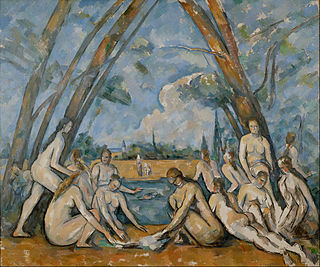 W
WThe Bathers is an oil painting by French artist Paul Cézanne first exhibited in 1906. The painting, which is exhibited in the Philadelphia Museum of Art, is the largest of a series of Bather paintings by Cézanne; the others are in the Museum of Modern Art in New York City, National Gallery, London, the Barnes Foundation, Pennsylvania, and the Art Institute of Chicago. Occasionally referred to as the Big Bathers or Large Bathers to distinguish it from the smaller works, the painting is considered one of the masterpieces of modern art, and is often considered Cézanne's finest work.
 W
WThe Beethoven Frieze is a painting by Gustav Klimt on display in the Secession Building, Vienna, Austria.
 W
WBroadway and 42nd Street is a 1902 painting by Childe Hassam which is part of the collection of the Metropolitan Museum of Art.
 W
WThe Call is a 1902 painting by Paul Gauguin, produced in Polynesia a year before the artist's death. It is now in the Cleveland Museum of Art.
 W
WThe Cave of the Storm Nymphs is a painting by British artist Edward Poynter, depicting three nude sirens or nymphs from Greek mythology that lure sailors to their deaths. Poynter painted two versions, one in 1902 and the other in 1903, with minor differences. The former is housed in the Norfolk, Virginia Hermitage Museum, and the latter is in the private collection of Sir Andrew Lloyd Webber. One of the depicted sirens is playing a golden stringed, tortoise-shell lyre, while the other two sirens rejoice amid the foundering ship, expecting to add to the cave’s treasure.
 W
WThe Crystal Ball is a painting by John William Waterhouse completed in 1902. Waterhouse displayed both it and The Missal in the Royal Academy of 1902. The painting shows the influence of the Italian Renaissance with vertical and horizontal lines, along with circles "rather than the pointed arches of the Gothic".
 W
WThe Demon Downcast is a piece by the Russian painter Mikhail Vrubel, created around 1901-1902.
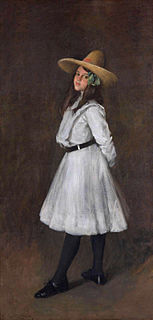 W
WDorothy is an oil painting by American artist William Merritt Chase. Created in 1902, it is currently part of the permanent collection in the Indianapolis Museum of Art.
 W
WFemme aux Bras Croisés, is a painting by Pablo Picasso done in 1902 during his Blue Period. The subject of the painting is unknown, but she may be an inmate of the Saint-Lazare hospital-prison in Paris.
 W
WLord Ribblesdale, sometimes known as The Ancestor, is a portrait in oils on canvas by John Singer Sargent of Thomas Lister, 4th Baron Ribblesdale, completed in 1902. The full-length portrait depicts Lord Ribblesdale in his hunting clothes. It measures 258.4 cm × 143.5 cm and has been held by the National Gallery in London since 1916.
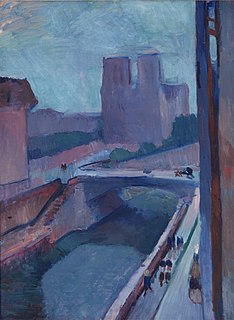 W
WNotre-Dame, une fin d'après-midi is a painting by Henri Matisse from 1902. Its somber coloration is typical of Matisse's works executed between the end of 1901 and the end of 1903, a period of personal difficulties for the artist. This episode has been called Matisse's Dark Period.
 W
WThe Oreads is an oil painting by the French artist William-Adolphe Bouguereau. Its dimensions are 236 × 182 cm.
 W
WThe Passing of Shah Jahan is a Miniature painting, painted by the Indian artist Abanindranath Tagore in 1902. The painting depicts a scene in which the fifth Mughal Emperor Shah Jahan stares upon the Taj Mahal on his deathbed, with his daughter at his feet. Initially involved with the dominant style of European Naturalism, Tagore's mentor Ernest Binfield Havell had introduced him to various types of Indian art. Of these varieties, Tagore was most impressed with old Mughal miniatures, which often featured emotionless, but detailed illustrations of scenes and characters. Incorporating this style with the traditional Indian artistic concept of Bhava', or emotion, Tagore had painted a scene based upon the growing re-interest in Indian history during the British Raj.
 W
WA Reclining Nayar lady is a painting by the Indian artist Raja Ravi Varma. The painting features a recumbent Nair woman, believed to be the character Indulekha from a Malayalam novel, with a book open in front of her while attended by a maid.
 W
WReminiscence of the Tempyō Era is a 1902 painting by yōga artist Fujishima Takeji (1867–1943). Inspired by nostalgia for the Tempyō era and, like his Butterflies and covers for the literary magazine Myōjō, an influential exemplar of Meiji romanticism, it has been designated an Important Cultural Property. It is part of the collection of the Ishibashi Foundation.
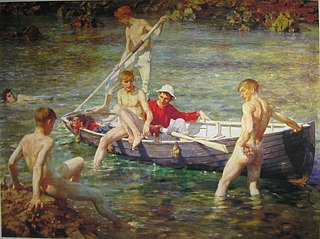 W
WRuby, Gold and Malachite is an oil-on-canvas painting by Henry Scott Tuke. It depicts six young men in and around a boat, bathing in the sea. It was painted near Falmouth and exhibited at the Royal Academy summer exhibition in 1902, along with two other works by Tuke, The Run Home and Portrait of Alfred de Pass. It was one of his greatest successes.
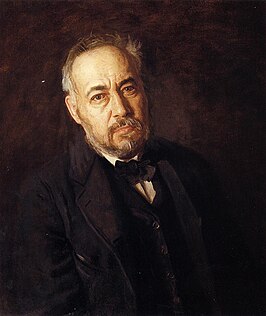 W
WSelf-portrait is an oil on canvas painting by Thomas Eakins, presented as a diploma piece upon his election as an Associate member of the National Academy of Design in 1902. Although Eakins included himself as an observer or participant in group portraits and genre scenes, this and a smaller unsigned and undated oil, thought to have been made at about the same time, are the only unadorned self-portraits he ever painted. Lloyd Goodrich wrote that it "is not only one of his finest head and bust likenesses, but a revealing human document; in the direct look of his remarkable eyes one can see strength, penetrating intelligence, and a touch of ironic humor."
 W
WWilliam M. Chase, N. A. is a 1902 painting by John Singer Sargent. It is part of the collection of the Metropolitan Museum of Art in New York.
 W
W W
W W
W W
W W
W W
W W
W W
W W
W